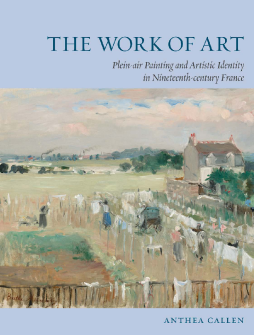
Additional Information
Book Details
Abstract
In The Work of Art, Anthea Callen analyzes the self-portraits, portraits of fellow artists, photographs, prints, and studio images of prominent nineteenth-century French Impressionist painters, exploring the emergence of modern artistic identity and its relation to the idea of creative work. Landscape painting in general, she argues, and the “plein air” oil sketch in particular were the key drivers of change in artistic practice in the nineteenth century—leading to the Impressionist revolution.
Putting the work of artists from Courbet and Cézanne to Pissaro under a microscope, Callen examines modes of self-representation and painting methods, paying particular attention to the painters’ touch and mark-making. Using innovative methods of analysis, she provides new and intriguing ways of understanding material practice within its historical moment and the cultural meanings it generates. Richly illustrated with 180 color and black-and-white images, The Work of Art offers fresh insights into the development of avant-garde French painting and the concept of the modern artist.
“Callen, probably more than anyone else working on nineteenth-century painting today, is able to combine an artist’s experience of studio practice with an art historian’s rigorous use of documentation. Her work is immensely valuable for its combination of sensitive visual observation and scrupulous attention to details of historical fact. . . . This book is a major accomplishment.”
— Richard Shiff, University of Texas at Austin
“Callen’s book is a fascinating exploration of the material practices of French outdoor landscape painters in the nineteenth century. Focusing on hardware, including folding seats, paint boxes, backpacks, palette knives, brushes, and newly available tube paints, Callen argues that this often overlooked dimension of the work of the outdoor landscape painter is crucial for understanding how plein air painting took form. Her discussion includes the class associations of painter’s smocks and trowels, as well as the gender restrictions of what was an almost exclusively masculine practice. The book is organized into four richly illustrated and carefully researched chapters. Readers first encounter the early techniques and procedures of practitioners of plein air landscape sketching, including Pierre-Henri de Valenciennes and Jean-Baptiste-Camille Corot, before moving to the coarse-grained and materialist concerns of Gustav Courbet, Camille Pissarro, and Paul Cézanne. The text concludes with a fascinating discussion of the neo-Impressionist landscapes of Georges Seurat and Paul Signac and their relationship to the traditional craft practices of needlework, embroidery, and weaving. Callen’s presentation and analysis of the hardware available to outdoor landscape painters contributes an important new dimension to the broader understanding of nineteenth-century French painting. . . . Highly recommended.”
— Choice
“It is a well-known story, but Callen brings to it the illumination of technical art history, combining an authoritative understanding of artists materials and how they were used with the history of their availability and practical application. Her focused investigation of process, or the work of art, is enriched by the latest developments in conservation science, archival research in the history of art materials and close visual examination of paintings, as well as by her own practice as a painter.”
— Burlington Magazine
“The rise of painting en plein air was a key change in French artistic practice in the nineteenth century. This study examines how this new approach informed the avant garde, leading to the Impressionist revolution.”
— Apollo Magazine
“Callen’s The Work of Art is a welcome return to the material and technical matter of Impressionist paintings. . . . Callen skillfully interweaves performative, social, and aesthetic evidence that propelled the identity-construct of male plein-air landscape painters. The author casts her evidential net wide. . . . Particularly compelling is that these tangents converge on the multilayered identity of (male) plein-air painters as manual laborers. . . . Callen’s eloquent descriptions of the painting and knifing process mirror the tactile plasticity of the thick pigments on the canvases she describes. Likewise, the author’s lively prose captures the dynamics of hand and tool movements not only as indexical marks of the making process, but also of the changing components of manufactured pigments. . . . We can conclude from Callen’s densely demonstrated deconstruction of Impressionist practices and the tactile materiality of the painted canvases that the complex manufacture of Impressionist paintings compels a sense of wonder. Indeed, Callen’s book is a testimony to the Impressionists’ achievement.”
— Nineteenth-Century French Studies
Anthea Callen is professor of art in the School of Art at the Australian National University, Canberra, and professor emerita of visual studies at the University of Nottingham, UK. Her many books include Art, Sex and Eugenics: Corpus Delecti and The Art of Impressionism: Painting Technique and the Making of Modernity.
